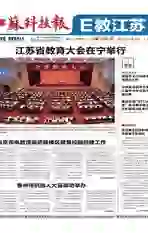CHARTING A COURSE FOR SUCCESS: AMERICA’S STRATEGY FOR STEM EDUCATION(Ⅳ)
2019-09-10
【譯题】制定成功之路:美国STEM教育战略(四)
Product of the COMMITTEE ON STEM EDUCATION of the NATIONAL SCIENCE & TECHNOLOGY COUNCIL
美国国家科学技术委员会STEM教育委员会
The most transformative discoveries and innovations take place at the junctures where disciplines converge. Discovery and innovation will be catalyzed by an education system that integrates knowledge and methods across STEM, the arts, and the humanities and requires students to ask and answer questions crossing traditional disciplinary boundary lines.
There are three objectives under this pathway:
Advance Innovation and Entrepreneurship Education
Innovation generally depends on a convergence of ideas at the intersection of different fields and sectors to produce new products or processes. In an increasingly competitive global economy, STEM education that emphasizes convergent processes and promotes problem-finding and creativity is needed to accelerate innovation and entrepreneurship. Education in these critical skills should play a larger role in STEM courses for learners from all demographics and communities to provide a pathway for more Americans to contribute to the Nation’s dynamic economy.
Key Federal actions needed to achieve this objective include:
·Review participation rates in federally funded competitions, challenges, and citizen science projects and apply best practices to attract a more diverse and inclusive community of participants where needed.
·Within Federal education and entrepreneurship investments, include support for activities that teach educators effective methods for making entrepreneurship education more inclusive and increasing the participation of underrepresented groups.
·Within Federal education and entrepreneurship investments, include support for activities that teach educators about the creation as well as the protection of intellectual property.
Make Mathematics a Magnet
Mathematics and statistics are foundational to success across all STEM fields of study, providing a universal language to describe and reason about models of real-world phenomena.
Mathematics continues to serve as a gateway to STEM majors that leads to higher-paying jobs and economic mobility. For the United States to produce a vibrant, diverse wave of talent for the future of STEM, mathematics must foster interest in and enthusiasm for science, technology, and engineering, drawing learners more deeply into these subjects—serving as a magnet, not a barrier, to further study.
Key Federal actions needed to achieve this objective include:
·Make Federal data more accessible for use in mathematics, statistics, and other STEM education courses, in user-friendly formats and accompanied by suggestions on how such data could be used in lessons.
·Prioritize support for programs and partnerships that integrate mathematics and statistics education in meaningful and applied contexts, including for educator upskilling.
·Identify and share mathematics and statistics education practices shown to retain diverse learners.
Encourage Transdisciplinary Learning
Problems that are relevant to people’s lives, communities, or society as a whole often cross disciplinary boundaries, making them inherently engaging and interesting. The transdisciplinary integration of STEM teaching and learning across STEM fields and with other fields such as the humanities and the arts enriches all fields and draws learners to authentic challenges from local to global in scale.
In order to conduct transdisciplinary or convergence research, scientists and engineers require a varied toolset that includes deep disciplinary knowledge, an acquaintance with the language and culture of the disciplines of their potential collaborators, and collaboration skills such as communication, ability to work with other people, critical thinking, analysis, and initiative.
Agencies also support STEM learners studying transdisciplinary problems through fellowships, scholarships, grants, and training. Undergraduates, graduate students, and postdoctoral fellows partaking in these opportunities gain first-hand insight into how transdisciplinary science and engineering is conducted, and learn about intellectual flexibility, communication, and teamwork.
Key Federal actions needed to achieve this objective include:
·Support research, development, and dissemination of effective transdisciplinary STEM education practices, programs, and policies.
·Expand support for STEM learners studying transdisciplinary problems through internships, fellowships, scholarships, and other training opportunities.
·Ensure that Federal activities in support of the recruitment, preparation, retention, and up- skilling of STEM educators incorporate or reflect transdisciplinary approaches featuring teaching that focuses on local and global community questions.
譯文
通往成功的道路(二)
让学生参与学科融合
最具变革性的发现和创新往往发生在学科交会的结合点。一个融合STEM、艺术和人文学科知识和方法的教育体系将推进发现和创新,并要求学生跨越传统学科的界线提出和回答问题。
这条途径有三个目标:
推进创新和创业教育
创新通常依赖于不同领域和部门之间的思想融合,从而产生新的产品或流程。在竞争日益激烈的全球经济中,STEM教育强调趋同过程,促进发现问题和创造力,这是加速创新和创业所必需的。这些关键技能的教育应该在面向所有人口和社区的STEM课程中发挥更大的作用,为更多的美国人提供为建设充满活力的经济做出贡献的途径。
为了实现这一目标,联邦政府需要采取以下措施:
·审查联邦政府资助的竞赛、挑战和公民科学项目的参与率,并在需要时应用最佳实践来吸引更加多样化和包容性的参与者社区。
·在联邦教育和创业投资活动中,包括支持向教育工作者传授有效方法的活动,使创业教育更具包容性,并增加代表性不足群体的参与。
·积极投资联邦教育和创业相关活动,包括支持教育工作者开展关于创造和保护知识产权的活动。
让数学变得更有吸引力
数学和统计学是所有STEM领域成功的基础,它提供了一种通用的语言来描述和解释真实世界现象的模型。
数学仍然是通向STEM专业的大门,这个专业将带来高薪工作和经济流动。为了让美国为STEM的未来培养一批充满活力、多样化的人才,数学学科必须培养学习者对科学、技术和工程的兴趣和热情,吸引他们更深入地学习这些学科,使其成为进一步学习的磁石,而不是障碍。
为了实现这一目标,联邦政府需要采取以下措施:
·使联邦数据更容易以用户友好的格式用于数学、统计和其他STEM教育课程,并附有如何在课程中使用这些数据的建议。
·优先支持在有意义和应用的環境中整合数学和统计教育的项目和合作伙伴关系,包括教育工作者能力的提升。
·识别和分享数学和统计教育实践,以留住不同类型的学习者。
鼓励跨学科学习
与人们的生活、社区或整个社会相关的问题常常会跨越学科边界,使它们具有内在的吸引力和趣味性。STEM教学和学习的跨学科整合,跨越STEM领域,并与人文和艺术等其他领域相结合,丰富了所有领域,并在规模上吸引学习者面对从地方到全球范围的真正挑战。
为了进行跨学科或融合研究,科学家和工程师需要一个多样化的工具集,包括深厚的学科知识、对潜在合作者学科语言和文化的了解,以及协作技能,如沟通、与他人合作的能力、批判性思维、分析能力和主动性。
联邦机构还通过奖学金、助学金和培训来支持研究跨学科问题的STEM学习者。参与这些机会的本科生、研究生和博士后研究员可以对跨学科的科学和工程如何进行有第一手的了解,并了解智力灵活性、沟通能力和团队合作能力。
为了实现这一目标,联邦政府需要采取以下措施:
·支持研究、开发和传播有效的跨学科STEM教育实践、计划和政策。
·通过实习、奖学金和其他培训机会,加强对研究跨学科问题的STEM学习者的各种支持。
·确保联邦政府支持STEM教育工作者的招募、准备、保留和提高技能的活动纳入或反映在跨学科的教学方法中,这些教学方法侧重于地方和全球社区问题。
